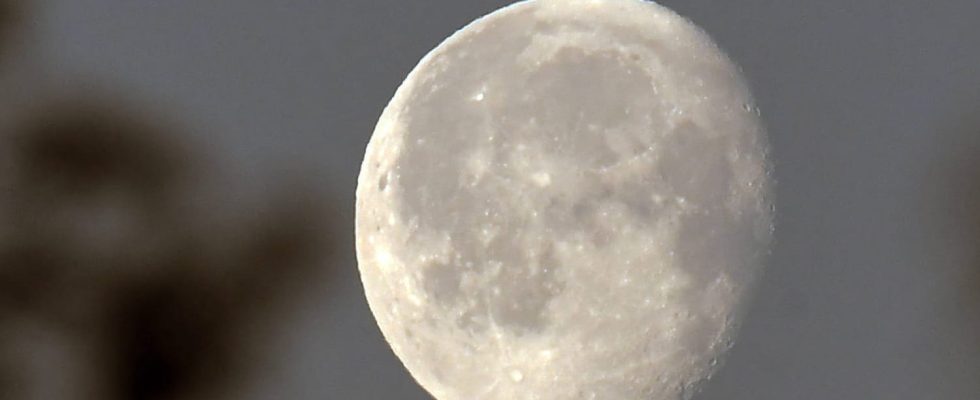SUPER MOON. The second Super Moon of the year 2023 takes place this Tuesday, August 1, 2023. At what time to observe this “Sturgeon Super Moon”? Follow the leader !
[Mis à jour le 1er août 2023 à 17h13] The “Sturgeon Super Moon”, the nickname for the second Super Moon of the year, will occur this Tuesday, August 1, 2023. The Super Moon is a fairly rare phenomenon. In the night sky, the Moon will appear 7.1% larger and 15.6% brighter than usual during the “perigee-syzygia” phenomenon, when full moon is at the point of its orbit closest to the Earth.
At what time and how to observe this Supermoon? Why is it a Super Moon and what is the origin of its name? Why do Native Americans call it Super Sturgeon Moon? How far will the Moon be from Earth tonight? What are its supposed effects? All the answers to your questions are in the guide below.
This month of August 2023 is a somewhat special month from an astronomical point of view since there will be two super moons: that of August 1, the “Sturgeon Super Moon” and that of August 31, the latter being nicknamed the “Super Blue Moon”. This Blue Moon will be “the largest and brightest Full Moon this year”, according to the astronomy site Starwalk. “It will be 7.2% larger and 15.7% brighter than an average Full Moon”, at a distance of 357,344 km from Earth.
The next Supermoon will be the second of the year 2023, dated Tuesday, August 1, at 8:31 p.m. Four Super Moons are visible this year 2023. After that of July 3, then Tuesday August 1, meet on Thursday August 31 and Friday September 29.
The phenomenon baptized “Super Moon” by astrologer Richard Nolle, but which scientists prefer to call “phenomenon of perigee-syzygy”, takes place when the point of the lunar orbit is at a minimum distance from the Earth. When is the Moon closest to the Earth? When located at a distance of less than 360,000 km (the average distance between the Earth and the Moon is 384,400 km) according to the Paris Observatory. On August 1, the full moon will be about 357,530 kilometers of the earth. It will be 7.1% larger and 15.6% brighter than a typical full moon.
In astronomy, this event is called “perigee-syzygia”, the name of Super Moon having nothing scientific, since it is an invention of the astrologer Richard Nolle in 1979. “A Super moon occurs when the full moon coincides with when the Moon comes closest to Earth in its elliptical orbit, a point called perigee,” explains the NASA website. By Super Moon, we therefore mean a celestial phenomenon that is due to two elements: the only satellite of planet Earth passes closest to us when it is a full moon evening. While waiting for the next photos, here are the most beautiful super moon pictures taken in France, the United States, China or even Russia:
The Estrugeon Super Moon bears this name given by Native American tribes because it coincides with the fishing season for this big fish around the great American lakes.
The Super Moon is not really observable until after sunset. sun, with the naked eye, using binoculars or telescopes. In order to observe a Super Moon in optimal conditions, it is necessary to equip yourself with astronomical glasses or a telescope, far from atmospheric pollution, or go to one of the clubs of the French Association of Astronomy (AFA). See the map.
A Super Moon appears slightly brighter and larger than a Full Moon, simply because it appears at perigee, at its closest orbit point to Earth, less than 360,000 km away.
Due to the proximity of the full moon to our planet Earth, its effects have an even stronger impact on tides, mood and sleep. Indeed, as explained by a Swiss scientific study carried out in 2013 published in the journal Current Biology, “a lunar rhythm can modulate the structure of sleep in humans”. This means that the time to fall asleep is extended by 5 minutes, deep sleep reduced by 30% and sleep duration by 20 minutes. Consequently, the level of melatonin, a hormone secreted during our sleep, which has a role to play in mood, is lower, which can cause irritability or even depression.
| DATE | HOUR | DISTANCE FROM EARTH |
| Monday July 3 | 1:39 p.m. | 361,934 km |
| Tuesday, August 1 | 8:31 p.m. | 357,530 km |
| Thursday August 31 | 3h35 | 357,344 km |
| Friday, September 29 | 11:57 | 361,552 km |
